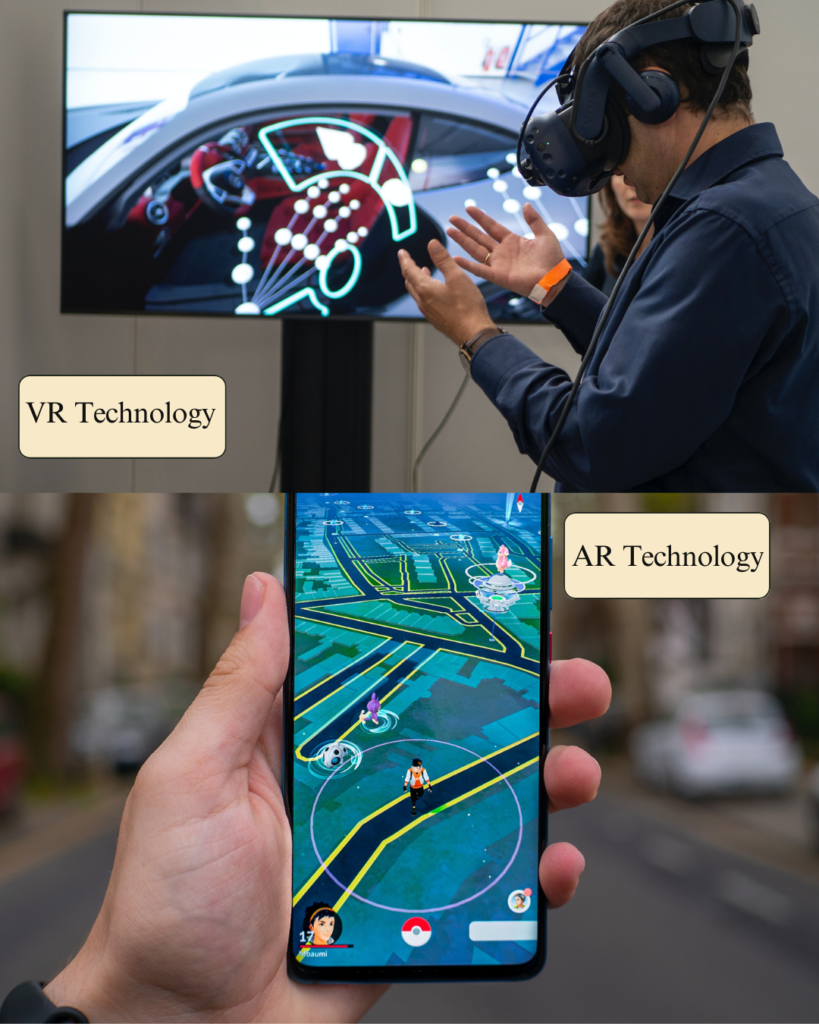In today’s fast-paced digital age, Virtual Reality (VR) and Augmented Reality (AR) have transcended the realm of science fiction to become indispensable tools that offer immersive experiences like never before. These transformative technologies have evolved far beyond their gaming origins, finding applications in education, healthcare, entertainment, and numerous other industries. In this exploration, we will delve into the captivating world of VR and AR, understanding their core principles, discovering their diverse applications, and witnessing how they are reshaping our perception of reality.
Understanding the Foundations
Before we dive into the captivating applications of VR and AR, it’s crucial to grasp the foundational concepts that make these technologies possible.
Virtual Reality (VR)
VR is an immersive technology that transports users into a computer-generated three-dimensional environment, completely replacing their physical surroundings. This is typically achieved using a head-mounted display (HMD) and motion-tracking sensors. The HMD covers the user’s field of view with a high-resolution screen, while sensors detect head movements, enabling users to explore and interact with the virtual world.
Augmented Reality (AR)
AR, on the other hand, supplements the real world with digital elements, enhancing what we see, hear, and feel. Unlike VR, AR doesn’t replace the physical environment; instead, it overlays computer-generated content onto the real world. This can be achieved through smartphones, tablets, or specialized AR glasses.
The Power of Immersion
The magic of VR and AR lies in their ability to create a sense of presence and immersion. With VR, users are transported to entirely new worlds, whether it’s the depths of the ocean, the surface of Mars, or a fantastical realm from a video game. The sensation of “being there” is so convincing that it can trigger real emotional responses.
AR, on the other hand, enhances the real world with additional information, blurring the lines between what’s real and what’s virtual. This capability has immense potential for industries seeking to enhance training, education, and various forms of visualization.
Diverse Applications
The applications of VR and AR are vast and varied, making them versatile technologies with the potential to revolutionize numerous fields. Let’s explore some of the most compelling uses.
-
Education and Training
VR and AR are redefining education and training. Imagine students dissecting virtual organisms in biology class, architects walking through virtual buildings before construction, or healthcare professionals practicing complex surgeries in a risk-free virtual environment. These technologies make learning more engaging and effective.
-
Healthcare
In the healthcare sector, VR and AR are helping both patients and professionals. Surgeons can simulate and refine complex procedures, reducing the risk of errors. Patients can undergo virtual therapy for pain management, phobias, or PTSD. AR is also aiding doctors by providing real-time patient data during surgery.
-
Entertainment
The entertainment industry has embraced VR with open arms. From immersive VR gaming experiences to virtual concerts and art exhibitions, the possibilities are limitless. AR is changing the way we consume media, with apps like Pokémon GO bringing gaming into the real world.
-
Tourism and Travel
VR allows travelers to explore destinations virtually before booking their trips. Museums use AR to provide interactive exhibits, enhancing visitors’ understanding of history and culture. These technologies are bridging geographical gaps.
-
Architecture and Design
Architects and designers use VR to walk clients through their projects, providing a realistic sense of scale and space. AR assists in visualizing furniture and decor in real-world settings before purchase.
-
Marketing and Retail
Businesses are adopting AR for marketing campaigns and enhancing the retail experience. AR apps let customers try on clothing virtually or visualize furniture in their homes before making a purchase.
-
Military and Defense
The military employs VR for training soldiers in realistic combat scenarios, improving their decision-making skills under pressure. AR enhances situational awareness by overlaying critical information on soldiers’ helmets.
-
Sports and Fitness
VR and AR are making fitness more engaging with immersive workouts and real-time performance data. They also enhance the viewing experience for sports fans by providing in-depth statistics and interactive elements during broadcasts.
Challenges and Future Developments
While VR and AR offer tremendous potential, they also face challenges. High costs, motion sickness in VR, and privacy concerns in AR are some of the hurdles that need to be overcome. However, ongoing advancements in hardware and software are steadily addressing these issues.
The future of VR and AR promises even greater integration into our daily lives. As technology becomes more accessible and affordable, we can expect to see broader adoption in fields like telemedicine, remote work, and social interaction.
Conclusion
In the not-so-distant past, the concept of immersive virtual and augmented realities seemed like science fiction. Today, these technologies are revolutionizing countless industries and offering experiences that were once unimaginable. Whether it’s exploring the depths of the ocean, training surgeons, or enhancing the way we learn, work, and play VR and AR are reshaping our world. As they continue to evolve, the only limit to their potential is our imagination. The future is indeed looking immersive.


Pingback: 5G Networks: Revolutionizing Connectivity for a Brighter Tomorrow -
Pingback: The Rise of Augmented Reality in E-commerce: Transforming How We Shop Online -